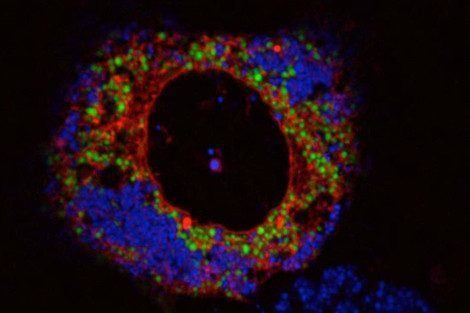For immediate release: May 9, 2013
Boston, MA — Harvard School of Public Health (HSPH) researchers have discovered that a particular type of protein (hormone) found in fat cells helps regulate how glucose (blood sugar) is controlled and metabolized (used for energy) in the liver. Using experimental models and state-of-the-art technology, the scientists found that switching off this protein leads to better control of glucose production from the liver, revealing a potential new target that may be used to treat type 2 diabetes and other metabolic diseases.
The study appears in the online May 7, 2013 issue of Cell Metabolism.
“Although it has long been recognized that a key event leading to development of type 2 diabetes is uncontrolled glucose production from the liver, underlying mechanisms have been elusive,” said senior author Gökhan S. Hotamisligil, chair of the Department of Molecular Metabolism and J.S. Simmons Professor of Genetics and Metabolism at HSPH. “We now have identified aP2 as a novel hormone released from fat cells that controls this critical function.”
The ability of one organ—in this case, the adipose tissue—to so directly and profoundly control the actions of another—the liver —is in itself very exciting, said Hotamisligil. “We suspect this communication system between adipose tissue and liver may have evolved to help fat cells command the liver to supply the body with glucose in times of nutrient deprivation. However, when the engorged fat cells lose control over this signal in obesity, the blood levels of aP2 rise, glucose is poured into the bloodstream and cannot be cleared by other tissues. The result is high blood glucose levels and type 2 diabetes.
Type 2 diabetes is a metabolic disease that impacts at least 26 million Americans and is linked to heart disease, stroke, and other serious health complications. The disease is often linked to obesity and insulin resistance and a loss of control of glucose production in the liver and insulin production in the pancreas, resulting in too much glucose in the blood.
The majority of cases of type 2 diabetes are related to failure of insulin action in the body. However, for decades researchers and physicians have been faced with a conundrum: not all who are obese or resistant to insulin develop type 2 diabetes. In fact, many patients who are severely obese never develop the disease. As a result scientists have theorized that an unknown factor is involved in regulating glucose metabolism in the liver, and perhaps the presence or absence of this element might determine who gets the disease.
“It was surprising to find that a critical hormone playing a pathological role in diabetes turned out to be the secreted form of aP2, which for decades has been considered a protein that resides inside the fat cells,” said Hotamisligil. In the new study, HSPH researchers first increased the levels of aP2 in normal, healthy mice to match the high blood aP2 levels seen in obese mice and humans. This resulted in impaired glucose metabolism. Next, they reduced the blood aP2 levels in obese and diabetic mice to low levels seen in lean healthy mice. This intervention restored glucose metabolism to its normal status. Therefore, the investigators reached the conclusion that the amount and action of aP2 in blood was critical for diabetes, opening up new avenues for potentially being able control or prevent type 2 diabetes. The researchers also identified a potential therapeutic role for a novel aP2 antibody that neutralizes aP2 activity and corrects type 2 diabetes in mice.
“The consequences of this discovery are profound, and the potential therapeutic applications by switching this protein off have the capability to reshape the way physicians treat diabetes,” said lead author Haiming Cao, postdoctoral fellow in the Department of Molecular Metabolism at HSPH.
This research was funded in part by National Institutes of Health grant DK064360. Individual authors were supported by fellowships from the NIH Roadmap (DK71507-04) and the American Diabetes Association; the Roadmap Grant R90 DK071507 from NIH, and fellowships from the Manpei Suzuki Diabetes Foundation and the Japan Society for the Promotion of Science. The technology described in this study is licensed to the biopharmaceutical company UCB, Union Chimique Belge.
“Adipocyte Lipid Chaperone aP2 is a Secreted Adipokine Regulating Hepatic Glucose Production,” Haiming Cao, Motohiro Sekiya, Meric Erikci Ertunc, M. Furkan Burak, Jared R. Mayers, Ariel White, Karen Inouye, Lisa M. Rickey, Baris C. Ercal, Masato Furuhashi, Gurol Tuncman, and Gökhan S. Hotamisligil, Cell Metabolism, online May 7, 2013 —Vol. 17, 1-11
For more information:
Marge Dwyer
617.432.8416
mhdwyer@hsph.harvard.edu
###
Harvard School of Public Health brings together dedicated experts from many disciplines to educate new generations of global health leaders and produce powerful ideas that improve the lives and health of people everywhere. As a community of leading scientists, educators, and students, we work together to take innovative ideas from the laboratory to people’s lives—not only making scientific breakthroughs, but also working to change individual behaviors, public policies, and health care practices. Each year, more than 400 faculty members at HSPH teach 1,000-plus full-time students from around the world and train thousands more through online and executive education courses. Founded in 1913 as the Harvard-MIT School of Health Officers, the School is recognized as America’s first professional training program in public health.
